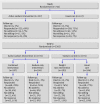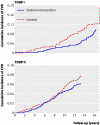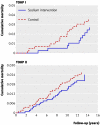Long term effects of dietary sodium reduction on cardiovascular disease outcomes: observational follow-up of the trials of hypertension prevention (TOHP)
- PMID: 17449506
- PMCID: PMC1857760
- DOI: 10.1136/bmj.39147.604896.55
Long term effects of dietary sodium reduction on cardiovascular disease outcomes: observational follow-up of the trials of hypertension prevention (TOHP)
Abstract
Objective: To examine the effects of reduction in dietary sodium intake on cardiovascular events using data from two completed randomised trials, TOHP I and TOHP II.
Design: Long term follow-up assessed 10-15 years after the original trial.
Setting: 10 clinic sites in 1987-90 (TOHP I) and nine sites in 1990-5 (TOHP II). Central follow-up conducted by post and phone.
Participants: Adults aged 30-54 years with prehypertension.
Intervention: Dietary sodium reduction, including comprehensive education and counselling on reducing intake, for 18 months (TOHP I) or 36-48 months (TOHP II).
Main outcome measure: Cardiovascular disease (myocardial infarction, stroke, coronary revascularisation, or cardiovascular death).
Results: 744 participants in TOHP I and 2382 in TOHP II were randomised to a sodium reduction intervention or control. Net sodium reductions in the intervention groups were 44 mmol/24 h and 33 mmol/24 h, respectively. Vital status was obtained for all participants and follow-up information on morbidity was obtained from 2415 (77%), with 200 reporting a cardiovascular event. Risk of a cardiovascular event was 25% lower among those in the intervention group (relative risk 0.75, 95% confidence interval 0.57 to 0.99, P=0.04), adjusted for trial, clinic, age, race, and sex, and 30% lower after further adjustment for baseline sodium excretion and weight (0.70, 0.53 to 0.94), with similar results in each trial. In secondary analyses, 67 participants died (0.80, 0.51 to 1.26, P=0.34).
Conclusion: Sodium reduction, previously shown to lower blood pressure, may also reduce long term risk of cardiovascular events.
Conflict of interest statement
Figures



Comment in
-
Salt and cardiovascular disease.BMJ. 2007 Apr 28;334(7599):859-60. doi: 10.1136/bmj.39175.364954.BE. BMJ. 2007. PMID: 17463420 Free PMC article.
-
Sodium reduction is enticing, but what is the full recipe?BMJ. 2007 May 12;334(7601):967. doi: 10.1136/bmj.39204.964306.BE. BMJ. 2007. PMID: 17493991 Free PMC article. No abstract available.
-
The final nail for sodium reduction.Curr Hypertens Rep. 2007 Nov;9(5):349-50. doi: 10.1007/s11906-007-0064-9. Curr Hypertens Rep. 2007. PMID: 18177578 No abstract available.
References
-
- Geleijnse JM, Kok FJ, Grobbee DE. Blood pressure response to changes in sodium and potassium intake: a metaregression analysis of randomised trials. J Human Hypertens 2003;17:471-80. - PubMed
-
- He FJ, MacGregor GA. Effect of modest salt reduction on blood pressure: a meta-analysis of randomized trials. Implications for public health. J Human Hypertens 2002;16:761-70. - PubMed
-
- Sacks FM, Svetkey LP, Vollmer WM, Appel LJ, Bray GA, Harsha D, et al. Effects on blood pressure of reduced dietary sodium and the dietary approaches to stop hypertension (DASH) diet. N Engl J Med 2001;344:3-10. - PubMed
Publication types
MeSH terms
Substances
Grants and funding
- HL37849/HL/NHLBI NIH HHS/United States
- HL37853/HL/NHLBI NIH HHS/United States
- HL37907/HL/NHLBI NIH HHS/United States
- HL37854/HL/NHLBI NIH HHS/United States
- HL37904/HL/NHLBI NIH HHS/United States
- HL37899/HL/NHLBI NIH HHS/United States
- HL37852/HL/NHLBI NIH HHS/United States
- HL057915/HL/NHLBI NIH HHS/United States
- HL37872/HL/NHLBI NIH HHS/United States
- HL37884/HL/NHLBI NIH HHS/United States
- HL37924/HL/NHLBI NIH HHS/United States
- HL37906/HL/NHLBI NIH HHS/United States
- R01 HL057915/HL/NHLBI NIH HHS/United States
LinkOut - more resources
Full Text Sources
Other Literature Sources
Medical
